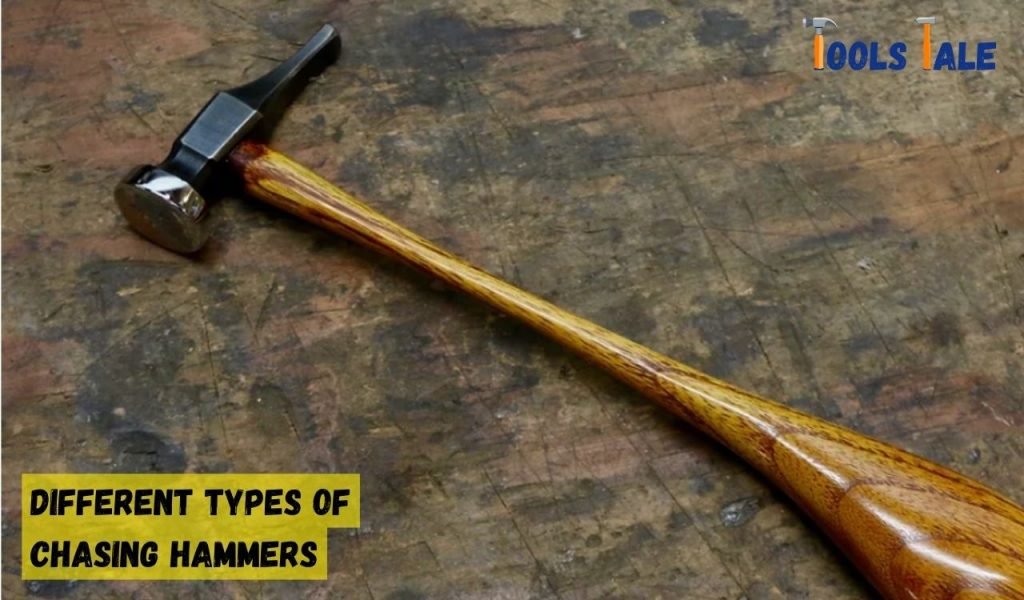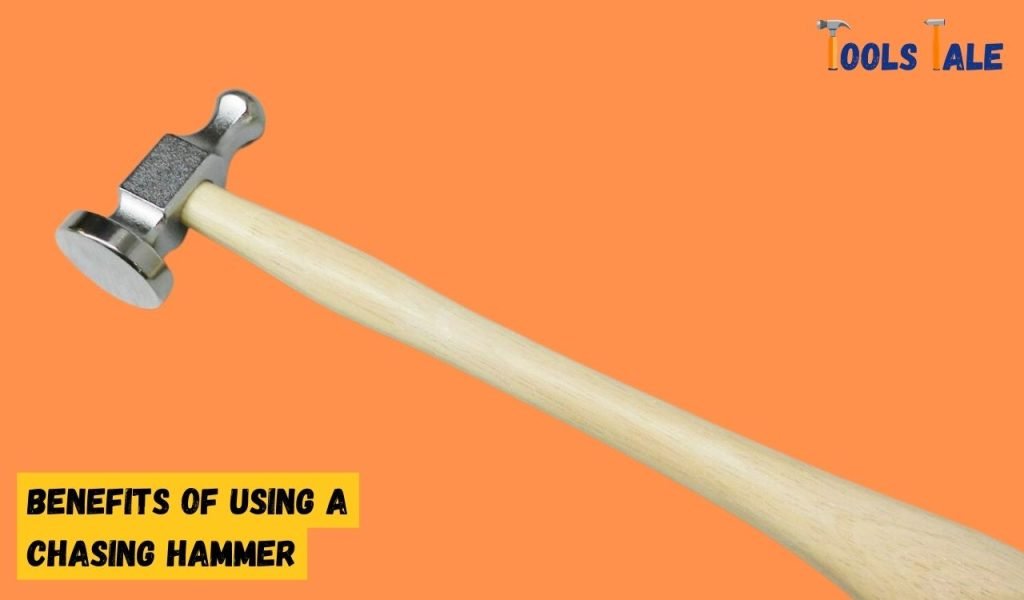Physical Address
304 North Cardinal St.
Dorchester Center, MA 02124
Physical Address
304 North Cardinal St.
Dorchester Center, MA 02124

What is a chasing hammer? If you’ve ever marveled at the exquisite textures and designs on metal jewelry or sculptures, chances are, a chasing hammer played a vital role. This unassuming tool holds the secret to transforming raw metal into mesmerizing works of art. Wondering how this magic happens? Stay tuned, as we embark on a journey to unravel the captivating world of the chasing hammer.
From unleashing your artistic expression to mastering precision techniques, this guide will empower you to wield the hammer like a true metalworking maestro. So, grab your creative spirit and get ready to make metal surfaces come alive with the artistry of a chasing hammer!
Key Summary: What Is a Chasing Hammer?
A chasing hammer is a dual-faced tool in metalwork and jewelry-making. It features flat and ball-peen faces, essential for shaping and texturing metals by striking them. This aids in creating intricate designs and contours in metal pieces.
A chasing hammer, also referred to as a repoussé hammer, is a specialized tool commonly used in the fields of jewelry making and metalworking. Its design typically consists of a sturdy head made from hardened steel, attached to an ergonomic handle for comfortable use.
Artisans and craftsmen employ the chasing hammer to execute various metalworking techniques, most notably chasing and repoussé. In chasing, the hammer is used to strike metal punches, creating intricate patterns and textures on the surface of metals. Repoussé, on the other hand, involves pushing the metal from the reverse side to achieve three-dimensional designs.
The chasing hammer’s versatility and ability to impart unique textures and designs have made it an indispensable tool for creative individuals. Jewelers use it to fashion exquisite jewelry pieces, while metalworkers utilize it to sculpt and shape metal sheets into captivating artworks.
With a legacy that spans centuries, the chasing hammer remains an essential part of the artist’s toolkit, offering endless possibilities for artistic expression and pushing the boundaries of metal craftsmanship. Its timeless appeal and versatility continue to inspire artisans worldwide, creating works of art that stand the test of time.
The chasing hammer, a vital tool in jewelry making and metalworking, serves various functions that allow artisans to craft exquisite designs and sculptures.
In the realm of jewelry making, the chasing hammer is a go-to tool for adding intricate textures and patterns to metal surfaces. Jewelers skillfully use it to create delicate floral motifs, fine lines, and captivating designs, elevating their jewelry pieces to new levels of artistry and aesthetics.
In metalworking, the chasing hammer finds application in sculpting and shaping metal sheets. This versatile tool allows artisans to craft three-dimensional forms and sculptures, with its impact on the metal surface enabling detailed and expressive designs.
Beyond its primary uses, the chasing hammer’s versatility extends to other creative and industrial domains. Blacksmiths and sculptors rely on it to forge unique metal pieces and decorative elements, showcasing its adaptability in various artistic endeavors.

In the world of jewelry making and metalworking, a chasing hammer is an indispensable tool that artisans rely on to create intricate designs and textures on various metals.
Understanding the different types of chasing hammers and their unique characteristics is crucial for selecting the right tool for specific projects. In this article, we will delve into the fascinating world of chasing hammers and explore the various types that fuel creativity in the hands of skilled craftsmen.
The traditional chasing hammer is the most commonly used type, featuring a flat, smooth face on one end and a ball pein on the other. This versatile hammer allows artisans to execute both chasing and repoussé techniques, creating detailed textures and three-dimensional designs on metal surfaces. Its balanced weight and comfortable grip make it a favorite among jewelers and metalworkers alike.
The narrow face chasing hammer is a specialized tool that provides increased precision and control. It boasts a slender and elongated face, enabling artisans to work on delicate details and narrow spaces with ease. Jewelry designers favor this type of hammer for intricate filigree work and fine line patterns, achieving impeccable results in their artistic creations.
The texturing chasing hammer is designed with a unique face that features various textured patterns, such as crosshatch, diagonal lines, or dimples. This hammer type allows artisans to impart a variety of textures onto metal surfaces, adding depth and character to their designs. It is particularly popular among metalworkers who seek to incorporate captivating textures in their sculptures and decorative pieces.
The square face chasing hammer, as the name suggests, has a square-shaped face on one end. This hammer type is ideal for forming sharp angles and crisp edges on metal surfaces, making it a valuable tool in creating geometric designs and patterns. Artisans who specialize in contemporary jewelry and metalworking often opt for this hammer for its precision in achieving clean lines and distinct shapes.
The planishing chasing hammer is a specialized tool used to smooth and refine metal surfaces after initial shaping with other chasing hammers. It features a round and smooth face that is perfect for finishing touches and removing any marks or imperfections left by previous hammering. This type of hammer is essential for achieving a polished and flawless appearance in the final stages of metalworking projects.
The chasing hammer, a powerful tool in the world of metalworking and jewelry making, holds the key to creating intricate designs and textures on various metals. To fully unleash its potential, artisans must master the art of using a chasing hammer. In this article, we will delve into the techniques and tips that empower artisans to wield this versatile tool with finesse and precision.

The chasing hammer empowers artisans to unleash their artistic expression on metal surfaces. With every well-placed strike, intricate textures and designs come to life, transforming raw metal into captivating works of art. From jewelry embellishments to metal sculptures, the chasing hammer serves as a conduit for creativity, allowing artisans to craft unique and personalized pieces.
One of the most significant benefits of the chasing hammer lies in its versatility in techniques. The flat face enables chasing, where controlled strikes create textures on the metal surface, while the ball pein end facilitates repoussé, shaping the metal into three-dimensional forms. This adaptability broadens the scope of artistic possibilities, inspiring artisans to experiment with diverse techniques and styles.
The chasing hammer’s weighted head and ergonomic handle provide excellent control and precision during the hammering process. This level of precision allows artisans to work on delicate details and intricate patterns with ease, adding a level of finesse and sophistication to their designs.
Texture creation becomes an art form in itself with the chasing hammer. By experimenting with different hammering techniques, artisans can achieve a myriad of captivating textures – from crosshatch patterns to diagonal lines and dimples. Each texture infuses character and depth into the metal, adding an exquisite touch to the final piece.
To ensure the longevity of the chasing hammer, proper storage and handling are crucial. Store the hammer in a dry and clean environment to prevent rust or corrosion. Avoid dropping the hammer or using excessive force, as it may cause damage to the hammer’s head and handle.
Regular cleaning and maintenance are essential for keeping the chasing hammer in optimal condition. After each use, clean the hammer’s face and handle with a soft cloth to remove debris and dirt. Periodically, apply a thin layer of oil on the hammer’s head to prevent rust formation.
Avoid overworking the chasing hammer by striking with excessive force or using it on materials beyond its intended capacity. Overworking may cause fatigue and strain on the hammer, leading to premature wear and tear.
Investing in a high-quality chasing hammer is a prudent choice for artisans seeking longevity and reliable performance. Choose a hammer with a durable head made from hardened steel and a comfortable handle that reduces hand fatigue during extended use.
Perform regular inspections on the chasing hammer to identify any signs of wear or damage. Check the hammer’s head for any signs of chipping or deformation and examine the handle for cracks or splintering. Promptly address any issues to prevent further damage and maintain the hammer’s functionality.
As with any tool, using a chasing hammer requires proper safety precautions to ensure a safe and enjoyable crafting experience. Here are some essential safety tips to keep in mind:
The chasing hammer opens a realm of artistic possibilities in metalworking and jewelry making, allowing artisans to infuse their creative visions into metal surfaces. By understanding its benefits, mastering hammering techniques, and following essential maintenance tips, artisans can ensure the longevity and reliable performance of this invaluable tool.
Embracing safety precautions fosters a secure and enjoyable crafting experience, safeguarding both the artisan and their artistic endeavors. With the chasing hammer in hand, artisans embark on a journey of artistic expression and craftsmanship, crafting stunning works of art that leave a lasting impression.
A chasing hammer is a tool commonly used in metalworking and jewelry making. Its primary purpose is to shape and texture metal, using its flat or slightly domed face for precise striking.
Using a chasing hammer involves holding the tool by its handle and striking the metal surface with controlled force. The flat face is often used for smoothing and shaping, while the ball-peen end is suitable for creating textures.
A chasing hammer is utilized for various metalworking tasks such as forging, forming, and texturing. It’s instrumental in creating intricate designs, raising metal, and detailing in jewelry making, blacksmithing, and other crafts.
The term “chasing” refers to the decorative work done on metal surfaces. The chasing hammer’s name reflects its role in working with metals, particularly in tasks involving detailed shaping, design, and ornamentation.
A chasing hammer consists of two ends: a flat or slightly domed face and a ball-peen end. The face is used for striking metal directly, while the ball-peen end offers an alternative surface for creating textures and shaping.
Yes, a chasing hammer can be used on various metals, including copper, silver, brass, and more. However, it’s essential to consider the hardness of the metal and adjust your striking force accordingly to prevent damage.
Chasing hammers are employed for techniques like raising (shaping metal against a stake), texturing (creating patterns), embossing (raising designs), and planishing (smoothing metal surfaces) in metalworking and jewelry making.
Yes, a chasing hammer is suitable for beginners. Its versatility and ease of use make it a valuable tool for those starting in metalworking. With proper guidance and practice, beginners can achieve satisfying results.
To ensure your chasing hammer lasts, keep it clean and dry after each use to prevent rust. Store it properly, away from moisture. Regularly check the handle for any loosening, and occasionally apply a light coating of oil to the metal parts to prevent corrosion.